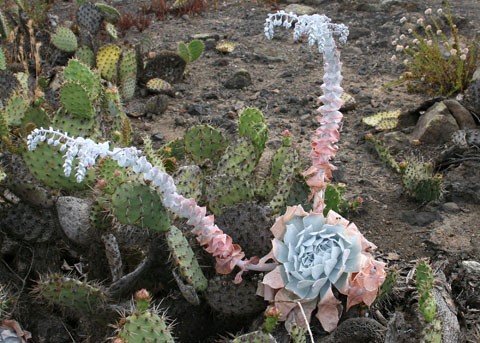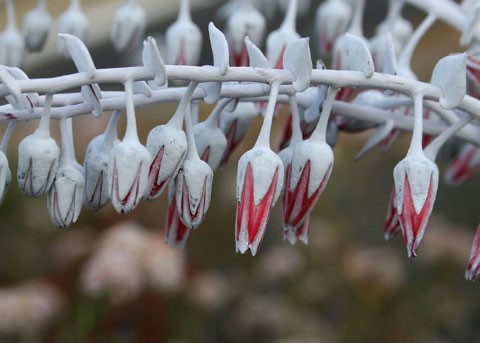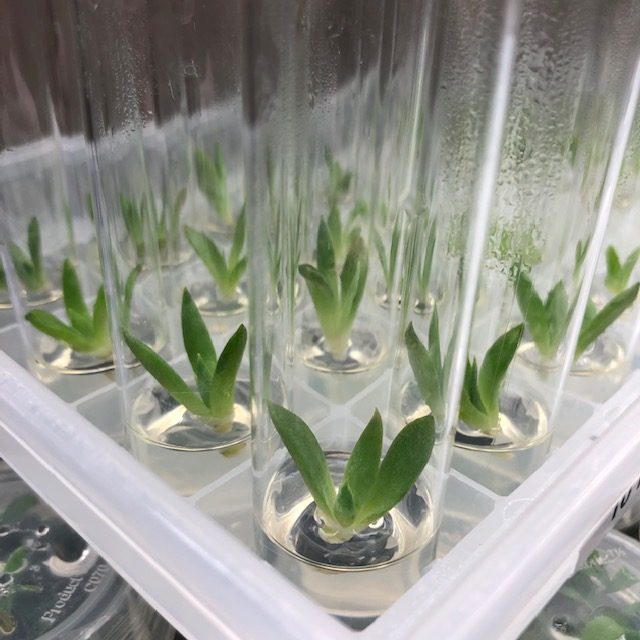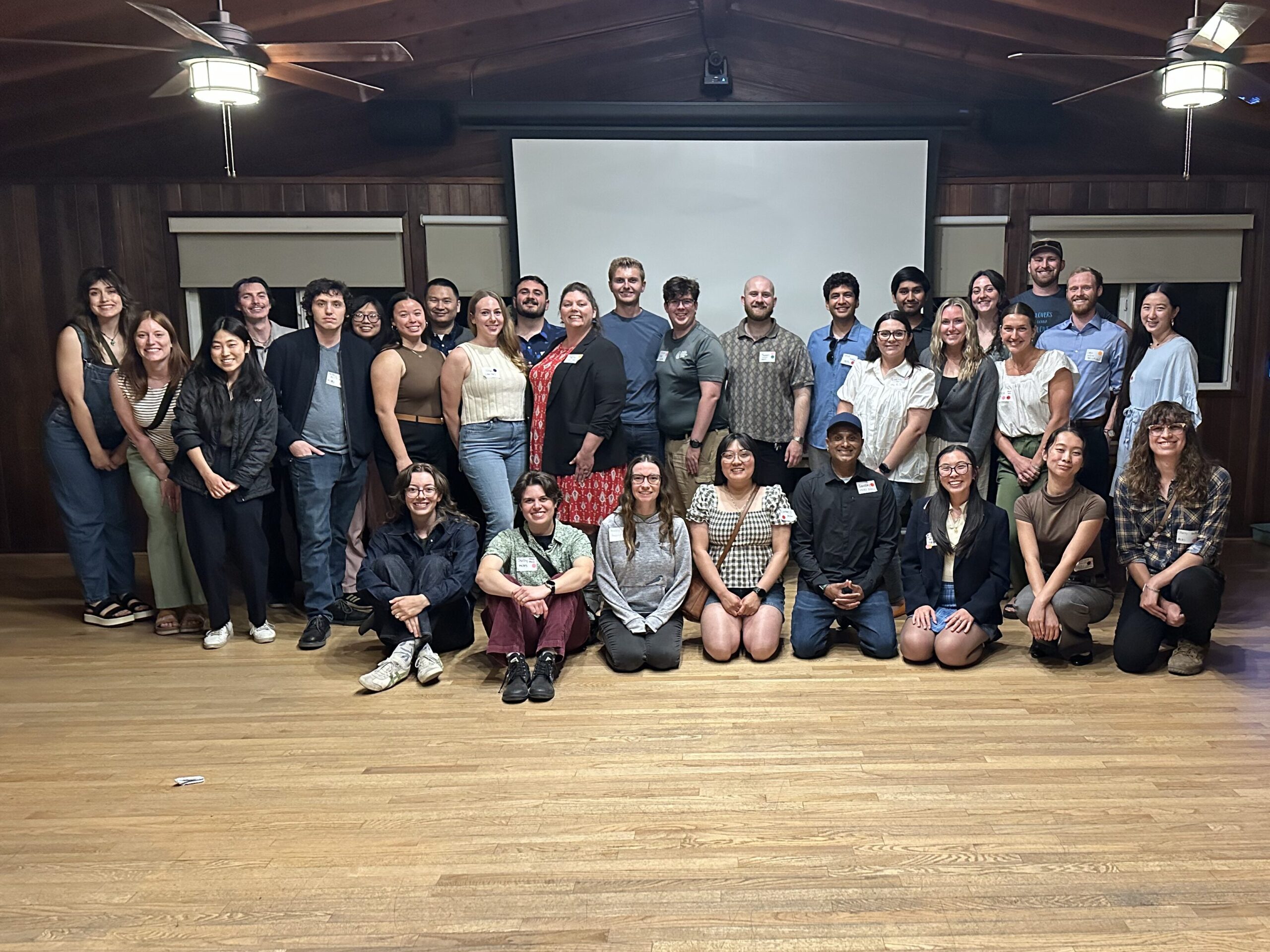Student Blog: Kevin Alison
Kevin Alison is a 2nd year MCRS student who will be graduating in June. His research also focuses on culturing beneficial mycorrhizal inoculums to combat soil pathogens as a well as propagating native ferns. His goal is to expand on this research and provide land managers and conservation agencies with additional resources for effective conservation and restoration.
Conservation through Cultivation: Growing Plants in Test Tubes to Prevent Extinction
When I was a child, I used to think aliens had landed on Earth and taken residence in the wilderness behind my house. These strange creatures had no legs, no eyes, round silver bodies with bright powdery textured scales, holding long skinny arms high above their heads to show off their glowing red fingertips. They perched quietly on steep cliff-faces and conversed only with hummingbirds and small bees that would stop to shake their brightly colored hands. Later, I was told by adults that these creatures were not extraterrestrials from outer space, but instead, a plant commonly called Chalk Liveforevers, or Dudleya pulverulenta. “Wow! A plant that can live forever?” I pondered. I didn’t know some plants had superpowers like the characters I would read about in comic books.

As I grew up, I remained enamored with this fascinating group of plants. I learned the name “Liveforevers” refers to the genus Dudleya, a group of plants in the Stonecrop family (Crassulaceae) that store water in their leaves to live in dry places. I also learned there are many different types of Dudleya, with about 50 species living along hillsides from Southern Oregon to Baja California. Despite having attractive features and low water needs, I rarely found Dudleya available at garden centers. Only a few specialty nurseries that grew native plants would have them and always in limited supply. I later learned that many of the species of Dudleya were also rare in the wild. Nearly two-thirds of the Dudleya in my home state is on the California Native Plant Society’s list of most endangered species. Nine of those species (or subspecies) are listed by federal agencies as threatened or endangered of becoming extinct. This listing includes the Laguna Beach Liveforever (Dudleya stolonifera), a species that only occurs on a few hillsides where I grew up. When it came time to choose a career as an adult, I was motivated to learn the art and science of growing plants, which required understanding their ecology. I was determined to learn this information to help ensure rare plants like Dudleya are not lost forever.
I first earned Associate degrees in both Environmental Horticulture and Natural Resource Management at College of the Desert in Palm Desert, California. During my studies, I worked as a horticulturalist at The Living Desert Zoo & Botanic Gardens. Although I loved the desert, I missed being near the ocean. So, after earning my Associate degrees, I moved to the Big Island of Hawaii to pursue a Bachelor’s in Coastal Resource Management at the University of Hawaii at Hilo. Hawaii is an incredible place to study ecology and evolution. Nearly 10,000 species are endemic to this island chain, meaning they only occur there and nowhere else in the world. Unfortunately, Hawaii is also an exceptional place to study conservation issues since 30% of the nation’s federally listed threatened or endangered species are from Hawaii despite only being less than 0.2 percent of the nation’s landmass (DLNR, 2010). During my studies in Hawaii, I learned of a new method of growing plants called Tissue Culture. The University was using this method to overcome unique challenges for many of the endangered species on the Islands. As a horticulturalist, I was fascinated by this method, and I hoped to apply this technique to threatened species in my home state of California.

Tissue culture is a method of growing plants in a clean setting free of any bacteria or fungus. This method typically requires growing plants in glass containers or test-tubes. This method is referred to in science as “in-vitro,” which is a Latin term meaning “In glass.” To grow plants using in-vitro, you have to provide all the necessary ingredients a plant would need in a jelly-like substance while also supplying light and preferred temperatures. Tissue Culture allows new individual plants, or clones, to be produced by stimulating the formation of shoots the same way plants produce new branches with plant hormones (Kyte & Kleyn, 1996). The University of Hawaii is using this method to grow many endangered Hawaiian plants. They are focused on species that have twenty or fewer individuals left in the wild, and traditional ways of growing them have failed (Sugii & Lamoureux, 2004). They use this method to increase the number of plants in the wild or keep them growing safely in the lab to ensure the species is not lost forever. When I graduated from the University, I achieved more than an education in not only Plant Tissue Culture but also an appreciation for science to come up with creative ways of preventing plant extinction.
When I returned home to Southern California, I began working at Tree of Life Nursery, which specializes in growing native plants for restoration and naturalistic gardening. I was ecstatic to be working at a nursery growing different species of Dudleya. We were also looking into new ways to grow some of our more challenging plants—those that were difficult to grow by seeds or cuttings. So, I converted an unused trailer into a small tissue culture lab. Soon afterward, I was accepted into the MCRS Program at UC Irvine to further my education in conservation and restoration science.
Then I heard the tragic news. The California Fish and Wildlife Service uncovered an international plant poaching operation in northern California that was wild-harvesting Dudleya by the tens of thousands and shipping them to parts of Asia to sell at high prices to exotic succulent collectors (CDFWS News, 2018). After investigations, UC Santa Cruz researcher and Dudleya expert Steve McCabe exclaims that poaching has likely occurred longer than anticipated, targeting many different species of Dudleya. For example, the Cedros Island Liveforever, Dudleya pachyphytum, is an endemic species only occurring in small populations on cliff-faces on Cedros Island off the coast of Baja. There are even reports that the poaching likely involved repelling from helicopters to harvest plants (Uhler, 2018; Mas Noticias BCS, 2017; S. McCabe, personal communication, 2019). Given that many Dudleya species are rare and endangered due to multiple causes (specific habitat needs, urban development, etc.), the threat of poaching could cause a rapid extinction of targeted species because the plants being shipped to Asia are not suited for that climate.

After hearing this upsetting news, I focused my MCRS Capstone project on finding a way to diminish wild harvesting and prevent losing these plants in the wild. Drawing from education and experience with growing plants for a living, I figured the poachers were responding to a lack of available plants and are capitalizing on the principles of supply and demand. Having grown Dudleya before from seed, these slow-growing plants can take a long time to grow to a mature size with attractive features. Furthermore, different Dudleya species breed with each other easilyin both the wild and in a nursery setting, resulting in a hybrid plant (Griffin, 2004; McCabe, 2004; McCabe, personal communication, September 24, 2019; Uhl & Moran, 1953). Since many Dudleya have similar looking features, crossbreeding makes it difficult to determine if the plant you are growing from seed is the species you are trying to grow or is a hybrid of multiple species. This situation creates a challenge for conservationists and can limit their ability to save the genetics of a species on the brink of extinction (Fiedler & Laven, 1996). Therefore, I proposed to apply the clonal method of plant tissue culture. This method will overcome these challenges while ethically producing high quantities of select Dudleya species. This effort will use the principles of supply and demand to stop poaching by making Dudleya widely available while decreasing the market price that drives the poaching incentive. As demonstrated at the University of Hawaii, this method will also help conservationists increase the number of plants in the wild while alsoproviding a safe place to preserve plants in the lab.
At the start of this project, I met with Steve McCabe to come up with a list of the most sought-after species by poachers as well as identify locally rare species in Orange County. Then, I began planning how to introduce these species into the sterile environment. I designed a plan to compare growing seeds in a greenhouse vs. on nutrient agar in the lab to see which method is more effective. I will also test different cleaning methods to eliminate competing bacteria and fungus without causing too much harm to the plants. Once the plants are clean and healthy in-vitro, I will then try to determine what combination of plant hormones cause new plant clones to form and exponentially increase the number of plants of a particular species.
There will be multiple benefits of using this method to produce Dudleya for a number of different interested groups. For plant collectors, an increased supply of rare Dudleya will be available to purchase at potentially lower prices without impacting the wild populations. For conservationists, a new tool will be added to their toolbelt to help restore populations of rare and endangered Dudleya and prevent extinction. For me, I will hope to see more Dudleya available at the garden centers and nurseries for people to appreciate their beauty in their gardens. Most of all, I will rest easier knowing that these will not go extinct in the wild and will live forever for future generations.
References
CDFWS News (2018, April 6) Wildlife Officers Arrest Three for Poaching Succulents in Humboldt County. California Department of Fish and Wildlife CDFW News. Retrieved from https://cdfgnews.wordpress.com/2018/04/06/cdfw-wildlife-officers-arrest-three-for-poaching-succulents-in-humboldt-county/
DLNR, Department of Land and Natural Resources (2010). Hawaii Statewide Assessment of Forest Conditions and Resource Strategy. Issue 6: Conservation of Native Biodiversity. Retrieved from http://www.dlnr.hawaii.gov/forestry/files/2013/09/SWARS-Issue-6.pdf
Fay, M.F. (1992). Conservation of Rare and Endangered Plants Using in-vitro Methods. In Vitro Cellular & Developmental Biology, 28(1), 1-4.
Fiedler, P.L., & Laven, R.D. “Selecting Reintroduction Sites.” In Falk, D.A., Millar, C.I, & Olwell, M., Editors(Eds.). Restoring Diversity: Strategies for Reintroduction of Endangered Plants, 157-170. Washington, DC: Island Press. 1996.
Griffin, K. (2004). On the troubles with identifying Dudleyas: and Telling the Differences among D. brittonii, D. anthonyi, and D. pulverulenta. Cactus and Succulent Journal, 76(5), 266-267.
Kyte, L., and Kleyn, J. (1996). “Plants from Test Tubes: An Introduction to Micropropagation.” 3rd edition. Portland, OR: Timber Press.
Mas Noticias BCS (2017). Militares decomisan plantas endemicas. Retrieved from https://masnoticiasbcs.com/mdpe
McCabe, S.W. (September 24, 2019). Personal communication [In-person]
Uhl, C. & Moran, R. (1953). The Cytaxonomy of Dudleya and Hasseanthus. American Journal of Botany. 40(7), 492-502.
Uhler, M. (2018). At the edge of California and the edge of existence: How siemprevive de Isla de Cedros (Dudleya pachyphytum [Crassulaceae]) was poached ever closer to extinction. CNPS 2018 Conservation Conference: Horticulture as a Part of Conservation. California Native Plant Society.Retrieved from https://conferencecnps.files.wordpress.com/2017/12/technical-presentation-abstracts-by-session.pdf



